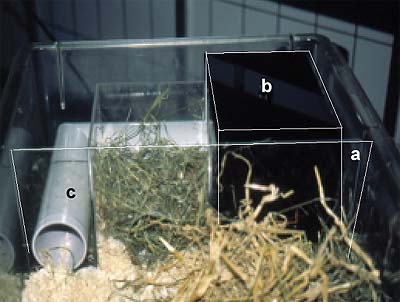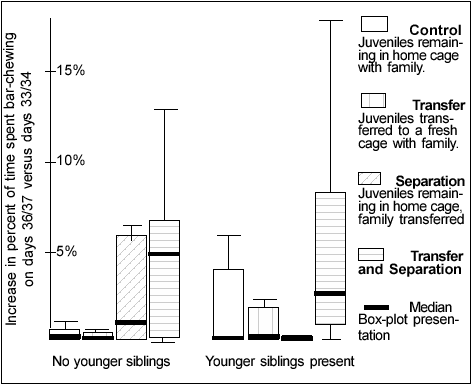 |
3R-INFO-BULLETIN 16
January 2001
The Authors
  |
Prof. Dr. Barbara König1 is head of the Animal Behaviour research group at the Zoological Institute, University of Zürich and Eva Waiblinger in her group carried out the present project as part of the doctoral thesis.
current address:
1Eva Waiblinger and Barbara König,
Animal Behaviour,
Zoological Institute,
University of Zürich,
Winterthurerstr. 190,
CH-8057 Zürich, Switzerland
Email: bkoenig@zool.unizh.ch
Editor
Peter Maier, Scientific Adviser of the 3R Research Foundation
Housing and husbandry conditions affect stereotypic behaviour in laboratory gerbils
Artificial conditions and behavioural abnormalities
It has long been known that inadequate housing and breeding conditions promote the development of abnormal behaviour such as stereotypies and replacement activities in farm and zoo animals. Recently, animal behaviour research has begun to focus on similar problems in laboratory animals[*]. The mechanism leading to behavioural abnormalities is hypothesised as follows: under natural conditions in the wild, animals interact with their biotic and abiotic environment, whereby internal and external stimuli serve to regulate the frequency of certain behaviour patterns. This enables organisms to adapt flexibly to differing environmental conditions. In domesticated animals, many behavioural mechanisms are still regulated in the same manner and by the same stimuli as in their wild ancestors. Under artificial housing conditions, the animals may not be able to adapt to the barrenness of their environment or cope with the lack of appropriate sets of regulating stimuli. As a result, they often show stereotypies, defined as the repeated performance of the same behaviour without apparent goal or function. In farm and zoo animals, stereotypies have successfully been treated by supplying the animals with an appropriate set of artificial environmental stimuli, also called environmental enrichment.
Investigations in laboratory gerbils
Mongolian gerbils (Meriones unguiculatus), which are often used for parasitological and neurological research, represent a useful model for stereotypies. Gerbils growing up under standard laboratory housing conditions typically develop two distinctive behavioural abnormalities: stereotypic digging and chewing on the bars of their cage. We analyse the causes of this behaviour by adding specific enrichment factors to the standard housing conditions or by modifying the handling of the gerbils during breeding. Afterwards we observe selected animals weekly from their birth to adulthood to quantify the frequency and duration of bouts of stereotypic behaviour. In addition, we measure cortisol levels in fresh faeces collected once a week (RIA 125 iodine-cortisol) as an indicator of chronic stress (data not yet analysed).
1. Simulation of burrows
In the wild, gerbils live in vast subterranean burrow systems which provide shelter against the climate and predators. Standard laboratory cages lack a burrow-like structure into which the animals can retreat. In such a situation, the gerbils might be highly motivated to attempt to create a burrow by digging. All their efforts remain unsuccessful, which might lead to stereotypical repetition of digging motions, permanent frustration or even chronic stress in the gerbils. We tested this hypothesis by adding an artificial burrow consisting of an opaque nest chamber accessible through a tunnel. Under such conditions, stereotypic digging was significantly reduced.

Fig. 1
Prototype of an artificial burrow that consists of three modules (a: separation wall, b: dark nestbox with removable lid and c: access tunnel) and can be easily integrated into a standard macrolone cage type IV.
2. Separation of juveniles and their families
Initially we hypothesised that bar-chewing in gerbils was either a replacement activity caused by the lack of appropriate chewable nesting material or a reinforced bar-manipulation caused by the close proximity of their food pellets to the bars of the cage-lid in the food hopper. Experiments showed, however, that neither of these factors had an influence on the development of bar-chewing.
Upon closer observation, we found that bar-chewing significantly increased after juvenile gerbils were separated from their families and housed in a separate cage with fresh bedding material (“Transfer” in Fig.2; WAIBLINGER & KÖNIG 1999). We therefore tested the influence of both the process of separation and the transfer to a fresh cage on the development of stereotypic bar-chewing. Juvenile gerbils significantly increased bar-chewing if separated from their family before the next litter (“younger siblings” in Fig. 2) was born. Bar-chewing might therefore reflect the juvenile animals’ motivation to return to their families, as long as there are no younger siblings present. By separating family and juveniles only after the birth of a younger litter in the family, the development of stereotypic bar-chewing can thus be reduced (“Separation” in Fig.2). The time interval between litters averages 35 days in gerbils, therefore we suggest not separating parents from their juveniles before the age of 5 weeks.

Fig. 2
Influence of the presence of younger siblings on the development of stereotypic bar-chewing measured over a 21 min observation period/animal/day on day 33/34 and 36/37.
Simple refinement is effective
So far, our experiments have shown that rather simple refinements in animal housing conditions and flexible timing of separation of adults from the juveniles can successfully reduce or even prevent specific stereotypic behaviours. We are currently testing the artificial burrows in a laboratory setting for their practicality (ease of cleaning) and their acceptance by the animals. Delayed separation will not affect other aspects of animal management since juvenile gerbils do not usually reproduce as long as they remain with their parents.
Published updated version of this Bulletin 16/2007 (PDF)
References:
- Baumans, V. & Van de Weerd, H.A. (1999): The influence of enriched housing conditions on experimental results in laboratory mice. (www.forschung3r.ch) 3R-Project 66-99
- Mason, G.J. (1993): Forms of stereotypic behaviour. In: Stereotypic animal behaviour: fundamentals and applications to welfare (Eds. Lawrence and Rushen), CAB international, Oxon, UK; pp.11-18
- Schnell, C.R. (1999): Telemetry in biomedical research: implications for animal welfare and scientific quality, Abstract, ATLA 27: 153
- Waiblinger, E. and König, B. (1999): Do the presence of nesting material and the location of the food presentation have an effect on the development of bar-chewing in laboratory gerbils? KTBL-Schrift (ISBN 3-7843-2116X, Aktuelle Arbeiten zur artgemässen Tierhaltung 1999) 391: 178-186
| [*] | Refinement of rodent husbandry conditions, a relevant issue?
|
| Dernières modifications: 30.01.2008 |